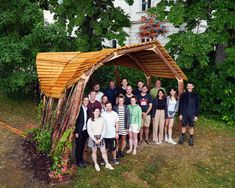BUILD.NATURE
The newly established doctoral School BUILD.NATURE promotes interdisciplinary research for designing and constructing sustainable building technologies.
BUILD.NATURE focuses on minimizing environmental impacts, integrating structures with natural surroundings, adapting buildings for future climates, implementing low to no-waste strategies and reducing energy consumption. Application of natural materials, efficient use of raw materials and side products are key factors in multiple adaptation strategies to increase resilience for buildings in many cities. Echoing with its three pillars of resilient buildings, materials and society BUILD.NATURE offers the course of “Cycle of materials, construction, building and resilience”. This course was an opportunity for the aspiring researchers to use their knowledge and create a physical outcome.
Started with multiple brainstorming sessions of different designs a pilot design was selected and after materials collections for the main structures of the shelter the whole process was defined. The major criterion implemented to select main materials was to use an outdoor durable wood species (oak or larch). Additionally, lower quality grades, like crooked stems or hardwood branches shall be utilized.
Luckily, there was already a lot of larch wood cuttings done in the training forest at Rosalia (Forchtenstein, Lower Austria) to choose from. For being a conifer, larch wood naturally grows almost completely straight. with the amount of about 0.7 m³ of smaller diameter larch was sourced and transported to Groß-Enzersdorf where the processing could be started.
To improve the planning and for final considerations for the design phase Person-Carried Laser scanning was used to create a digital twin of the larch logs in the forest. The 3D point clouds represented the stems with all their bends and shapes and provided us an accurate list of lengths and diameters. Based on the 3D models of the raw material, the final design could be finished in CAD. Subsequently the machining data could be prepared. Using a robot, the slots for the gusset plate joints were carved into the logs. The gusset plates were also milled by the robot from plywood panels, and wooden dowels were used to assemble the parts to arches. Overall, there was no metal connector used to assemble the arches and the building elements can be de-assembled physically.
The final structure was erected at the BOKU facility in Groß-Enzersdorf in mid-June. Therefore, metal screw foundations were used to connect the arches to the ground while being removable. The larch board roofing was more work than expected – or maybe due to the lack of professional carpenters. To improve the weather resistance and shelter capacities, the final greening was planted and climbing aids were added.
In company of all supervising Professors from different BOKU institutes, the construction was revealed to the public with an opening ceremony. Luckily there was a serious rainfall on that day, so the sheltering function of the roof could even be tested.
All in all the project was a very valuable course that brought researchers of the different BUILD.NATURE related BOKU institutes together. In a lively exchange an interdisciplinary gain of knowledge could be achieved. The learning to mostly point out was the experience of merging so many different fields of expertise and streamlining the potential to one final common project.
The members of the doc school would like to give their acknowledgements to BUILD.NATURE and the supervisors for providing such an opportunity. Thank you!

